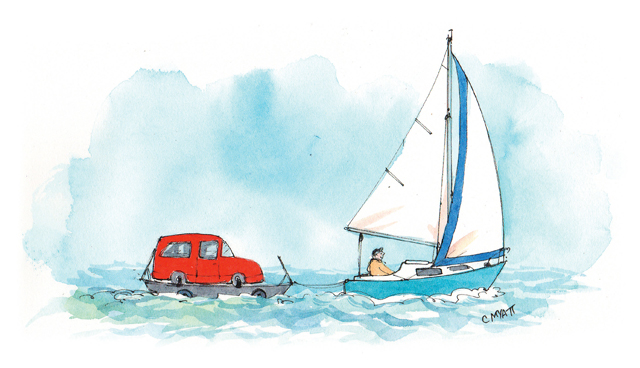PHEW! In fact DOUBLE PHEW! Marlin’s in the boat shed at last and I’ve been so busy panicking I haven’t had much time to upload my truly amateur mobile phone video, writes Dave Selby.
This traumatic little episode, which is redeemed by a rare guest appearance by Bart, should serve as a master class in boat neglect. It happened about a month ago now. I was truly ashamed when I gave Marlin the once over at Maldon Yacht Club.
She was covered in mould, the trailer tyres were flat and she’d more or less taken root. I really should’ve removed the road wheels and jockey wheel and put the trailer up on blocks.
Now I’m paying the price. The jockey wheel, which cost around £35, is seized solid, despite squirting cans of expensive stuff on it. It’s now junk, so I’ll add it to my boatjumble stock! If you buy three or four more like it you’ll have enough to assemble one decent one.
I was hoping that I’d have Maldon Yacht Club all to myself when I turned up to tow Marlin back, but the moment I had her hitched up people appeared out of the bushes to watch and comment on my famed reversing technique which goes perfectly well when people aren’t watching.
The five-minute drive to my boat shed passed off without incident, but manhandling Marlin into my shed was a pig of a job with a jockey wheel that wouldn’t turn. This time I was grateful for the crowd that emerged cos it took the brawn of four burly sailors and the promise of four pints to heave her into place.
The only thing is once she was in the shed I realised I’d forgotten to pressure-wash her, but didn’t have the nerve to ask the guys to help drag her out again. They’d all disappeared down The Queen’s Head at any rate.
The to-do list is massive, but it starts with checking all the structural elements. First job is to check the keel, which slides up and down vertically in a trunk. It’s a neatly shaped aerofoil with 200lb of lead in the bottom and raises and lowers on a long screw. To check it I’m going to have to put a joist across the cabin top opening, wind the keel box lid up, strap it to the joist, then wind the keel up to meet it. If it sounds simple, it isn’t. It’s half a day’s work.
Next I’m going to remove and check the wooden compression post. It’s what stops the boat collapsing into a flat-pack when the rigging’s tensioned, so it matters. Trouble is water can get into the void under the cabin floor where the base of the post rests on the hull. If that’s rotten the compression post is doing nothing more than provide a mounting for my oil lamp. It’s also festooned with hooks which serve as my wardrobe and hanging locker.
The third structural element to check is the standing rigging. I’m not going to tell you when it was last replaced cos I don’t know. All I’ll say is that I bought Marlin in 2004 and I haven’t replaced the standing rigging in my ownership, so it’s an absolute no-brainer to replace it all.
I’ll also be getting to grips with boat electrics. Marlin doesn’t have any, and I’ve survived fine with an oil lamp, battery echo-sounder and LED lamps for cabin ambience. Truth is I’m reluctant to install an electrical system, but I’ve been persuaded of the necessity.
It’s got nothing to do with navigation or sailing, but it’s purely down to the demands of the modern digital equipment – video cameras, tablet, mobile phone etc – that will keep me in touch. I’m also going to be using digital nav for the first time, and as I’ll be without access to shore power for days, possibly weeks, I need power on board. Blimey, I’ve got a lot to do.
Hitch horror and trailer trauma – Dave Selby’s latest podcast
Dave Selby asks 'Why must boat trailers be such a drag?' in his latest column published in Practical Boat Owner…
Waterproof your trailer light plug
Boat trailer electrics, especially trailer light plugs are very susceptible to damage, either through the wires being pulled out or…
Tying a yacht onto her trailer
Make sure she's safe with these tips.
Trailer-sailing? Tow your boat safely
Simple stop and check technique
More trailer reversing tips
Keep that trailer in line..
Launching from a trailer
Tips for going from road to river
Keep clear of freewheeling trailer winches
Don't try and stop the spin!
Reversing a trailer
How to remember which way to turn
Is your road trailer legal?
There's only one way to find out
Two people electrocuted after yacht hits power lines
Two people were electrocuted while moving their yacht in Scotland's Outer Hebrides when the mast hit live power lines













